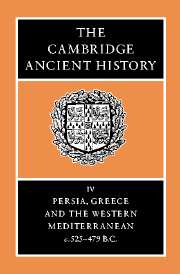Crossref Citations
This Book has been
cited by the following publications. This list is generated based on data provided by Crossref.
Manning, Joseph G.
2007.
The Cambridge Economic History of the Greco-Roman World.
p.
434.
Morris, Ian
2007.
The Cambridge Economic History of the Greco-Roman World.
p.
211.
Jongman, Willem M.
2007.
The Cambridge Economic History of the Greco-Roman World.
p.
592.
Alcock, Susan E.
2007.
The Cambridge Economic History of the Greco-Roman World.
p.
671.
Schneider, Helmuth
2007.
The Cambridge Economic History of the Greco-Roman World.
p.
144.
Von Reden, Sitta
2007.
The Cambridge Economic History of the Greco-Roman World.
p.
385.
Saller, Richard P.
2007.
The Cambridge Economic History of the Greco-Roman World.
p.
87.
Osborne, Robin
2007.
The Cambridge Economic History of the Greco-Roman World.
p.
277.
Morris, Ian
Saller, Richard P.
and
Scheidel, Walter
2007.
The Cambridge Economic History of the Greco-Roman World.
p.
1.
Dietler, Michael
2007.
The Cambridge Economic History of the Greco-Roman World.
p.
242.
Sallares, Robert
2007.
The Cambridge Economic History of the Greco-Roman World.
p.
13.
Van Der Spek, Robartus J.
2007.
The Cambridge Economic History of the Greco-Roman World.
p.
407.
2007.
The Cambridge Economic History of the Greco-Roman World.
p.
769.
Harris, William V.
2007.
The Cambridge Economic History of the Greco-Roman World.
p.
511.
Morley, Neville
2007.
The Cambridge Economic History of the Greco-Roman World.
p.
570.
Giardina, Andrea
2007.
The Cambridge Economic History of the Greco-Roman World.
p.
741.
Bedford, Peter R.
2007.
The Cambridge Economic History of the Greco-Roman World.
p.
302.
Davies, John K.
2007.
The Cambridge Economic History of the Greco-Roman World.
p.
331.
Cherry, David
2007.
The Cambridge Economic History of the Greco-Roman World.
p.
720.
Leveau, Philippe
2007.
The Cambridge Economic History of the Greco-Roman World.
p.
649.





